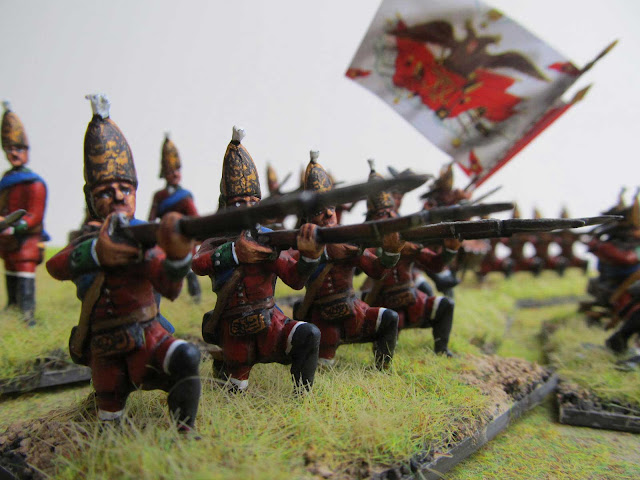1. Nature of the Game
The game is oriented towards the battles of the SYW. Mobility, tactics, and speed are imitated as closely and realistically as possible to resemble the original mid-18th century combat we’re trying to emulate. There are only a few situations that rely on the element of chance (e.g. throwing dice), the majority is according to your own decisions and the power and skills of your army. The game also has an offensive emphasis.
2. Basics
A. Deployment
There is a defending army and an attacking one. The defenders place their forces, consisting of artillery, cavalry and infantry, first and occupy the best available position. Then the attackers place their army.
B. Movement
The attackers have the first move.
A move signifies that every unit in the army can be moved simultaneously. So the whole army can be moved.
The rules for moving are:
infantry: 1 field (10cm | 1/3ft)
cavalry: 3 fields (30cm | 1ft)
artillery: 1 shot or move 1 field or turn (only if more than 60°). Shooting and moving at the same time isn´t possible.
If you have a limber, move the cannon/mortar also 30 cm.
infantry and cavalery can move AND fire simultaneously.
Then the enemy moves and so on.
C. Shooting
If a regiment approaches another one at a distance of 1 field, they can open the fire.
You take dices with as many points as your regiment has soldiers and throw dice. The enemy does the same. The difference of the results marks the losses. Remove the bases that have been killed.
# Background of this rule: muskets were fairly inaccurate during this time period
If you have grenadiers in your regiment, 2 of them can throw a hand grenade.
They can be thrown and kill 2 enemies each.
For the cavalry, the points are as follows:
light dragoons 2pts/man
heavy dragoons 3pts/man
hussars 2pts/man
cuirassiers 2pts/man
# idea: cavalry had more guns or side arms to fire
D. Melee
If a regiment touches another, the close fight begins.
Count your soldiers and the ones of the enemy by their skills - the difference marks the losses.
# background of this rule: well-disciplined soldiers fight better than recruited troops.
Skills:
musketeer/fusilier 1 pt/man
grenadier 1,5 pts/man
pikeman 0 pts/man vs. infantery, but 2 pts/man vs. cavalery
officer 2 pts/man
musician/standard bearer 1 pt/man
dragoons 2pts/man
hussars 2pts/man
cuirassiers 3pts/man
They can be thrown again and kill 2 enemies each.
## Example:
1 grenadier regiment fights with a musketeer regiment; both consist of 25 figures.
Count grenadiers: 24 soldiers and bearers + 1 officer = 36+2 = 38 pts.
Count musketeers: 24 soldiers and bearers + 1 officer = 24+2 = 26 pts.
Result: Take 12 musketeers away.
Same to all other fights.
3. Special effects
E. Cavalry´s special attack
If there are 1 or 2 fields between the cavalry and the enemy, the cavalrymen can accelerate to gallop and move into the infantry´s rank. Hereby the center of the infantry will be pushed back 1 field and 4 infantrymen were trampled to death and killed.
If you no longer have complete regiments, count: 3:1 (3 cavalrymen kill 1 infantryman).
Then start to count the skills (see D).
# Background of this rule: The cuirassier-effect of Seydlitz at Kuehnersdorf against the Russian lines, where the cuirassiers trampled the Russians to death.
F. panic and Retreat
If a regiment is being attacked by the enemy and thinks it will lose, its officer can decide to retire 2 fields (flee or panic). The next turn the regiment may not move because it has to reorganize.
# Background of this rule: The panicked retreat of the French at Rossbach.
G: artillery shooting
The cannon fires 5 fields and kills at close range: 3men / wide range: 2men
The mortar fires 4 fields and kills 3men
wider range: To hit the planned target, you must roll a die.
If you roll a 1 or 2 you’ve hit the field to the left, a 3 to 4 is a direct hit, and a 5 to 6 is a hit on the field to the right.
You need 2 hits to destroy a cannon or a mortar by artillery.
The mortar needs only 1 shot to destroy a cannon.
4. End of the game
The winner is the side that:
- takes the enemy general captive
- or forces the enemy general to give up
- or conquers 3/4 of the battlefield´s territory




































